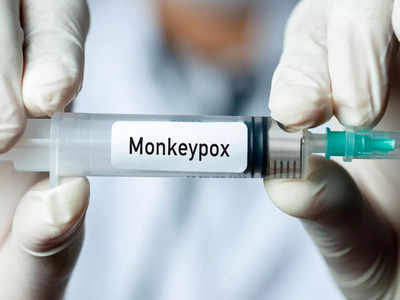- News
- lifestyle
- health-fitness
- health-news
- Monkeypox declared global health emergency: Symptoms, causes, prevention and everything you need to know
Trending
This story is from July 24, 2022
Monkeypox declared global health emergency: Symptoms, causes, prevention and everything you need to know
While the world only recently started recovering from the deadly COVID-19 pandemic, the discovery of monkeypox, a fatal disease found in the US and Europe has perturbed several countries and caused havoc. 3413 confirmed monkeypox cases and one death has been reported to the World Health Organization (WHO).

While the world only recently started recovering from the deadly COVID-19 pandemic, the discovery of monkeypox, a fatal disease found in the US and Europe has perturbed several countries and caused havoc. 3413 confirmed monkeypox cases and one death has been reported to the World Health Organization (WHO).
Monkeypox is a mild infection which comes from the wild fierce African animals.The disease was first detected in the year 1958 when two pox outbreaks occurred in colonies of monkeys kept for examination. It was at that time that this disease got termed as “monkeypox” as reported by the US Centers for Disease Control and Prevention (CDC). Monkeypox was first detected in 1970 in the Democratic Republic of Congo (DRC).
Read: Sign on your skin that could signal serious deficiency of Vitamin A
The symptoms of this disease are quite similar with smallpox symptoms. Squirrels, Gambian pouched rats and dormice have also been detected with this infection apart from monkeys. Mostly tropical African rainforests are colonized by animals who are prone to this disease. However, the spread of monkeypox in other parts of the world is creating havoc. The Democratic Republic of Congo (DRC) has been reported with the highest number of cases.
The Congo strain and the West African strain are the two variants of monkeypox. The Congo strain is more fatal than the West African strain. While the Congo strain has the mortality rate of 10%, the West African strain has a lower mortality rate of 1%.
This disease can pass on to humans if they get bitten by a monkeypox infected animal or come in contact with the infected animal’s blood, body fluids or fur. Consuming the meat of the diseased animal without properly cooking it might also lead to the spread of this infection.
The disease can be transmitted among human beings by getting in contact with the clothing, bedding or towels used by the infected person who has rashes, skin blisters or scabs. The cough and sneeze droplets of the infected person can also be contaminable. The virus is also suspected to be sexually transmissible as reported by the experts. However, the virus is not so infectious among humans.
The latency period of the monkeypox virus is 21 days after which the symptoms start arising. The symptoms of monkeypox are lighter as compared to the smallpox symptoms. Fever, headache, muscle pain, exhaustion and swollen lymph nodes are some of the symptoms of the monkeypox virus. Followed by these symptoms, people start having rashes on their skin which often begin to appear on their face and then spread to the other body parts. The rashes keep spreading until they form a scab and shed off. This disease lasts for a period of two to four weeks.
As reported by the World Health Organization (WHO), places like central Africa having insufficient healthcare facilities, 1 in 10 infected people die if they are prone to the virus. However, in most of the cases patients recover within a span of two to four weeks.
There is no specific treatment which has been discovered for the monkeypox virus. It is medically advised for the patients to stay isolated in a hospital so that the disease does not spread and the symptoms are cured if they reoccur. Smallpox vaccines are used in the US for monkeypox patients which are 85% effective. Antivirals and vaccinia immune globulin are also proven to be curable for the monkeypox patients.
The Center for Disease Control and Prevention (CDC) has advised people to stay away from those colonies which are inhabited by the monkeypox infected animals. Getting in contact with substances like the diseased animal’s bedding is also strictly prohibited. Isolation is recommended for the monkeypox infected patients.
In case someone has been in contact with the infected patient or animal, then he/she should wash their hands properly with soap and water or use an effective alcohol-based sanitizer. Wearing a PPE kit while treating the patient is a must for healthcare professionals and caregivers.
FAQs
Monkeypox is a mild infection which comes from the wild fierce African animals.The disease was first detected in the year 1958 when two pox outbreaks occurred in colonies of monkeys kept for examination. It was at that time that this disease got termed as “monkeypox” as reported by the US Centers for Disease Control and Prevention (CDC). Monkeypox was first detected in 1970 in the Democratic Republic of Congo (DRC).
Read: Sign on your skin that could signal serious deficiency of Vitamin A
The symptoms of this disease are quite similar with smallpox symptoms. Squirrels, Gambian pouched rats and dormice have also been detected with this infection apart from monkeys. Mostly tropical African rainforests are colonized by animals who are prone to this disease. However, the spread of monkeypox in other parts of the world is creating havoc. The Democratic Republic of Congo (DRC) has been reported with the highest number of cases.
Delhi has been reported with its first case of monkeypox on 24th July, 2022. The 31-year-old man has been admitted in the Maulana Azad Medical College and has fever and skin lesions. The patient has no travel records but has currently returned from Himachal Pradesh.
Variants of monkeypox
The Congo strain and the West African strain are the two variants of monkeypox. The Congo strain is more fatal than the West African strain. While the Congo strain has the mortality rate of 10%, the West African strain has a lower mortality rate of 1%.
How can humans get infected
This disease can pass on to humans if they get bitten by a monkeypox infected animal or come in contact with the infected animal’s blood, body fluids or fur. Consuming the meat of the diseased animal without properly cooking it might also lead to the spread of this infection.
The disease can be transmitted among human beings by getting in contact with the clothing, bedding or towels used by the infected person who has rashes, skin blisters or scabs. The cough and sneeze droplets of the infected person can also be contaminable. The virus is also suspected to be sexually transmissible as reported by the experts. However, the virus is not so infectious among humans.
Symptoms of monkeypox
The latency period of the monkeypox virus is 21 days after which the symptoms start arising. The symptoms of monkeypox are lighter as compared to the smallpox symptoms. Fever, headache, muscle pain, exhaustion and swollen lymph nodes are some of the symptoms of the monkeypox virus. Followed by these symptoms, people start having rashes on their skin which often begin to appear on their face and then spread to the other body parts. The rashes keep spreading until they form a scab and shed off. This disease lasts for a period of two to four weeks.
Is monkeypox a deadly disease?
As reported by the World Health Organization (WHO), places like central Africa having insufficient healthcare facilities, 1 in 10 infected people die if they are prone to the virus. However, in most of the cases patients recover within a span of two to four weeks.
Treatment for monkeypox virus
There is no specific treatment which has been discovered for the monkeypox virus. It is medically advised for the patients to stay isolated in a hospital so that the disease does not spread and the symptoms are cured if they reoccur. Smallpox vaccines are used in the US for monkeypox patients which are 85% effective. Antivirals and vaccinia immune globulin are also proven to be curable for the monkeypox patients.
Measures you can take to prevent monkeypox
The Center for Disease Control and Prevention (CDC) has advised people to stay away from those colonies which are inhabited by the monkeypox infected animals. Getting in contact with substances like the diseased animal’s bedding is also strictly prohibited. Isolation is recommended for the monkeypox infected patients.
In case someone has been in contact with the infected patient or animal, then he/she should wash their hands properly with soap and water or use an effective alcohol-based sanitizer. Wearing a PPE kit while treating the patient is a must for healthcare professionals and caregivers.
FAQs
- What is monkeypox?
Monkeypox is an unusual ailment caused by the infection of the monkeypox virus. The virus is a part of the family of variola virus, which belongs to the genus Orthopoxvirus, the virus which results in causing small pox. - What are the signs of monkeypox?
The initial symptoms of the monkeypox disease include high fever, headache, muscle pains, back pain, swelling of glans, tiredness and trembling. - How does monkeypox spread?
Monkeypox can be contagious in several ways, the virus can be transmitted by person-to person direct contact or getting in touch with the infected person's rashes, scabs or bodily fluids can also cause the spread of the disease. It can also spread through respiratory secretions of the diseased person by having a face to face direct contact with that person or performing intimate activities such as kissing, cuddling or sex. - How to prevent monkeypox transmission?
A monkeypox patient should seek medical help, cover his face properly with a mask and avoid close proximity with other people until he/she is healed properly
End of Article
FOLLOW US ON SOCIAL MEDIA









